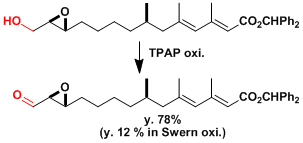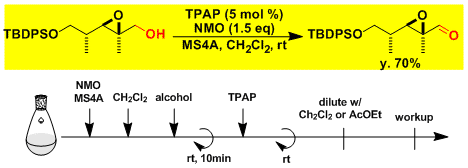- Generality
- Reagent Availability
- Experimental User Friendliness
- Criteria #4
- Criteria #5
-
General Characteristics
The oxidation of alcohols to aldehydes or ketones can be catalyzed by TPAP (nPr4N+RuO4–; TetraPropylAmmonium Perruthenate) which is air- and moisture-tolerant and also soluble in organic solvents. It is not as strongly oxidizing as ruthenium tetroxide and does not cause olefin cleavage or overoxidation of aldehydes to carboxylic acids. Simple procedure and the autocatalytic nature are other important characteristics. The mild reaction conditions are especially suited to unstable compounds or compounds containing labile protective groups.
-
General References
・Griffith, W. P.; Ley, S. V.; Whitcombe, G. P.; White, A. D. J. Chem. Soc. Chem. Commun. 1987, 1625. DOI: 10.1039/C39870001625
・Review: Ley, S. V. et al. Synthesis 1994, 639. doi:10.1055/s-1994-25538
-
Reaction Mechanism
Ru (VII) and Ru(VI) are thought to be the active species. The reaction is autocatalytic and the actual mechanism is not as simple as the one shown below. The presence of water hinders the formation of the autocatalyst, thus a drying agent such as MS4A is used. NMO acts as the reoxidant of the ruthenium species.

-
Experimental Procedure
TPAP oxidation of alcohol to aldehyde.[1]

-
Experimental Procedure
The aldehyde synthesis by the oxidation of a primary alcohol.[1]

-
Experimental Tips
-The residue of TPAP can be removed easily with a short pad of silica gel.
-There is a workup procedure involving a wash with Na2SO3 to reduce the excess NMO.
-The reaction could start violently on a large scale, thus TPAP and NMO should be added carefully. An empirical rule is that if the reaction doesn’t occur in 10 minutes in the presence of excess NMO, it won’t proceed any further.
-Dichloromethane is used commonly but the use of acetonitrile as a cosolvent often improves the yield.
-
References
[1] Griffith, W. P.; Ley, S. V.; Whitcombe, G. P.; White, A. D. J. Chem. Soc. Chem. Commun. 1987, 1625. DOI: 10.1039/C39870001625
-
Related Books
[amazonjs asin=”3527306420″ locale=”US” title=”Modern Oxidation Methods”]
[amazonjs asin=”0198556640″ locale=”US” title=”Oxidation and Reduction in Organic Synthesis (Oxford Chemistry Primers, 6)”]

